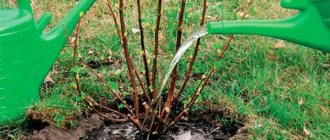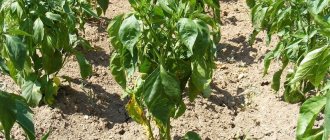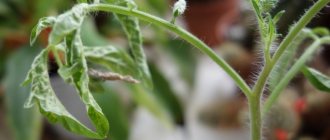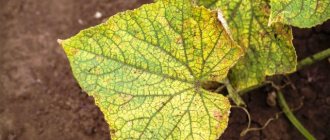Healthy tomatoes have green leaves.
A change in color indicates disturbances in the development of the plant and is expressed by the appearance of a blue or purple tint. All gardeners need to know why the leaves turn this color and what needs to be done.
The article describes in detail what causes certain changes in the color of leaves and stems, as well as ways to combat ailments.
Why do the foliage and stems of tomatoes change color?
Every plant contains pigments - coloring substances “anthocyanins”. Because of them, red, blue, or shades obtained as a result of mixing these colors appear. The color of diseased shoots changes gradually, first from below. An inconspicuous lilac or pink tint appears, which turns into purple.
If no action is taken, the leaves will turn bright purple or blue. They also curl. The stem becomes hard and brittle, and the fibers on it become coarser. Tomatoes weaken and wither. Next we will look at why this happens and what tomatoes lack, the leaves and stems of which change color.
Phosphorus deficiency
The lack of this component is dangerous during the development of roots and the appearance of the ovary. Tomatoes require 5 times less phosphorus than nitrogen. With this mineral:
- growth energy is provided;
- sugar content increases;
- high-quality fruit pulp is formed;
- productivity increases.
Tomatoes accumulate phosphorus and gradually use it up throughout the season. If there is a lack of this microelement, tomatoes will grow worse and bloom later. And if the fruits set, the weight will gain slowly and they will not ripen for a long time.
Seeds from these fruits cannot be collected. This is due to the fact that with phosphorus deficiency in tomatoes, nitrogen is poorly absorbed. Therefore, plant development stops and the fruits become small.
Bushes that have enough phosphorus tolerate cold weather more easily, and they are also more resistant to disease. They have a strong root system. The fruits can be easily transported and are resistant to damage. Therefore, if there is little phosphorus in the soil, fertilizing is required. And with a lack of this mineral, the leaves turn blue or purple.
Low temperature
It must be taken into account that the absorption of phosphorus at low temperatures is poor. If the soil temperature drops to +12 degrees and the air temperature to +14, then this mineral will not reach the tomatoes.
Cold weather can lead to impaired growth of tomatoes and the appearance of purple stems and leaves. Tomatoes are heat-loving plants that need a temperature of at least +20 degrees. Fruits absorb phosphorus poorly even at elevated levels (+40 degrees).
Unsuitable soil
Nightshades are demanding plants that require balanced soil. A deficiency of valuable components leads to their death. Tomatoes require several important components:
- magnesium;
- potassium;
- nitrogen;
- zinc.
A deficiency of any substance negatively affects the growth and productivity of the plant. An imbalance in the mineral composition of the soil can be detected by looking at the tops: when phosphorus is deficient, the lower foliage suffers. And a lack of magnesium affects young leaves at the top.
The blueness of seedling stems at the base may indicate an overdose of manganese during soil disinfection. In some cases, these are characteristics of the variety or hybrid.
Seedlings may turn purple due to the large amount of alkali in the soil. For tomatoes you need neutral or slightly acidic soil. Due to the large amount of acids and alkalis, liquid phosphorus fertilizers take on a solid form and therefore do not have the desired effect.
Lack of light
Plants require sunlight for normal development. Tomatoes develop normally if the illumination is at least 10 hours a day. With short daylight hours, the leaves may turn purple.
Daylight hours should be no more than 12 hours. Excessive lighting also negatively affects the culture, just like a lack. Tomatoes, seedlings and adult plants require rest as nutrients are absorbed in the dark.
How to grow healthy tomato seedlings at home: 6 top tips
Purple leaves appear on the bottom of young tomato seedlings if the gardener does not follow the recommendations for growing them. There are certain rules that minimize the risk of any problems with the crop and ensure the production of healthy, abundantly fruiting plants:
- optimal light regime - the plant should be kept under lamps in the morning and evening, be sure to turn off the equipment at night;
- You can avoid pulling the seedlings if you remove several lower leaves and bury them;
- if it is necessary to slow down the growth of the crop (so that the seedlings do not outgrow), pick 1-2 times;
- Watering is carried out only as the soil dries; the soil should not be allowed to dry out;
- to accelerate the growth of seedlings, it is permissible to use preparations such as “Athlete”;
- treatment with any growth stimulator will be useful during periods of formation of two true leaves, picking, and planting in open ground.
You should not be afraid of the appearance of a purple color on the leaves of tomato seedlings, because this is not always a sign of disease or poor care.
If you act correctly, the condition of the plant will quickly normalize, its appearance will become natural, and the previous change will not affect the yield.
Elena Vasilyeva
Purple spots over the entire surface of the plate
Purple leaves are not the norm. The reason may be unsuitable soil, lack of light, temperature violations, or phosphorus deficiency. But this usually happens when the soil is unbalanced. Whatever the reason, this leads to the plant having a diseased appearance. You should not expect a rich harvest from such plants.
If purple spots appear, it is advisable to spray them with water-soluble superphosphate. The procedure should be carried out in the morning or evening, when there is no strong exposure to the sun's rays.
What to do to remove purple color from tomato seedlings
So, we figured out the causes of the problem. Let's look at what to do if the color changes.
Raising the air temperature
If you find that the reason for the purple seedlings is precisely the low temperature, then you need to immediately take certain actions to normalize the temperature regime.
- Move the container with the plants to a warmer place.
- If seedlings freeze on a cold surface, then it is necessary to immediately place some kind of insulating material under the container, for example, polystyrene foam, foil polystyrene foam.
- If there is a draft coming from somewhere, it is necessary to insulate this place.
Replenishing phosphorus deficiency
If by external signs you determine that the tomatoes have turned purple due to a lack of phosphorus, you need to fertilize the plants with the appropriate fertilizer. To feed seedlings, you can use the following phosphorus fertilizers (with quickly digestible phosphorus):
- monopotassium phosphate;
- superphosphate (it is more effective to use double superphosphate);
- complex fertilizer, for example, Agricola for tomatoes, peppers and eggplants.
If there is phosphorus in the soil, but is not available to plants, then you can use a special preparation “Phosphatovit”. This drug contains bacteria that convert inaccessible phosphorus compounds into an accessible form for seedlings.
Note! Once the phosphorus deficiency is corrected, leaves that have already turned purple will most likely not be able to return to their normal green color. However, this is not a reason to worry, because in general everything is fine with the plant and the new leaves will have a normal shade.
Blue-green tint only below
This is a sign of a lack of nutrients:
- magnesium;
- potassium;
- nitrogen;
- zinc
Lack of components slows down growth and reduces yield. Deficiency can be determined by the tops. Usually the purple color on the bottom of the leaf appears due to a lack of phosphorus.
If this problem occurs, you need to spray the leaves with water-soluble superphosphate. The procedure is carried out in the morning or evening, when there are no bright rays of the sun.
We invite you to watch a video on how to help tomatoes whose bottom part of the leaf has turned blue:
Causes of leaf color change
After identifying a pathology, the first thing you need to do is find out its cause as quickly as possible. Treatment options will depend on this.
Low temperature
The most common reason is cold indoors. Often, tomatoes are located on the window and are exposed to drafts and frequent temperature changes.
The same thing happens when they are already planted in open ground. When the air and soil become colder than +15-16 degrees, tomato seedlings turn purple and stop growing. If only the leaves have turned blue, then the bushes can still be saved, but if the process has spread to the legs and stems, it will be much more difficult to save the tomatoes.
Lack of fertilizers
The second reason is closely related to low temperature. When it decreases, the roots stop absorbing fertilizers from the soil, and the plant experiences a lack of nutrients.
This primarily concerns phosphorus, which stimulates the growth of tomato seedlings. The color changes first from below, then the stem and veins turn blue. The edges of the leaves become dry and crumble easily. The stem acquires a woody structure, turns red, and the thin hairs on it turn into dry spines. Young foliage changes shape; they can be elongated or curled. These signs indicate phosphorus starvation of young tomatoes.
If the tomatoes were regularly fed, it means that they stopped absorbing microelements due to the cold. In this case, you need to deal with low temperatures, and not increase the amount of fertilizing - this can lead to rotting of the roots. In addition, acidic soils also slow down the absorption of minerals from the ground, and plants begin to suffer from vitamin deficiency.
Other reasons
Other reasons are less common, but you also need to pay attention to them when finding out. One of them is too hot weather and lack of water. Even with regular watering under the scorching rays of the sun, the water evaporates so quickly that the roots do not have time to absorb it. It also does not linger in the leaves, which is why they not only turn blue or red, but also wither.
Oddly enough, pets can be the cause of blue leaves. Cats or dogs may become addicted to marking garden beds or urinating on them. The ingress of this liquid disrupts the acid balance of the soil.
Perhaps there is no problem at all: some varieties are characterized by a purple color of the first leaves. Therefore, if the reason is not found, it is worth looking at the photo of seedlings of this variety.
Purple stem
It appears when there is an overdose of manganese, which is used to disinfect soil. Sometimes this is a feature of the variety or hybrid. Another purple stem appears when there is a lack of phosphorus.
The deficiency can be eliminated by spraying with water-soluble superphosphate. The solution should have a concentration of 1%. Spraying is carried out in the morning or evening, when there is no bright sun.
Replenishment of phosphorus deficiency
And yet the tomato seedlings turned purple - what to do in such a situation? We need to quickly make up for the lack of phosphorus. Why are the bushes supplied with additives, which include the missing element? Many people are well aware of such names as ammophos, diammophos, superphosphate, double superphosphate. So, this is the nutrition that tomatoes really need now.
What to do when tomato seedlings have purple leaves and stems underneath? To do this, take superphosphate (1 cup) and pour it with boiling water in a volume of also 1 cup. This mixture is kept for 8-12 hours. After which it is poured into a bucket of water. Root watering is organized at the rate of 1 liter for a pair of plants. Foliar feeding involves spraying the foliage with a phosphorus solution (0.5%) from a spray bottle.
Organics are an excellent replacement for mineral fertilizers. In this connection, it is good to use ordinary ash or bone meal for root and foliar feeding. Composts are made from plant materials, which are natural phosphorus fertilizers. To do this, they take feather grass, hawthorn, wormwood, thyme, and red rowan fruits. When saturating the soil with phosphorus, the main thing is not to overdo it. After all, an excess of a substance is just as detrimental to tomatoes as a deficiency. Externally, a phosphorus surplus will affect the foliage - in its yellowing and falling, the presence of necrotic spots of a brown tint.
Leaves change color and curl
This occurs when there is a nutritional imbalance. The color and shape of the leaves change, and deformation is observed. Such signs appear both with an excess and with a deficiency of microelements. This is not the norm, so timely help is important.
It is necessary to develop a suitable nutrition system in which all the necessary elements will be introduced during watering. Some valuable components are added with fertilizers. Timely help consists of fertilizing with organic matter and stove ash.
Symptoms and problem detection
The appearance of spots on tomato foliage is a symptom that cannot be ignored . The source of the problem can be determined by the color and appearance of the formation.
The purple color of the foliage most often indicates the need to replenish the soil . The color, uncharacteristic for tops, is produced under the influence of the anthocyanin pigment. The lack of useful microelements forces plants to intensively produce this substance.
The color of the tops does not change rapidly . First, the lower leaves change color: pink or lilac spots form on them below, which over time acquire a rich purple color. The leaf blade becomes dull, the veins become coarser, and spots appear and spread to the rest of the shoots.
Why is it dangerous?
A change in the color of seedling leaves from green to purple is considered harmless if it is not accompanied by the appearance of plaque. But you still have to take measures to preserve the health of the plant. In advanced cases, degradation of the seedlings is possible, which can cause its death
Leaves that have turned purple may begin to curl . Changes occur in the trunk: it loses its elasticity and becomes brittle. The villi covering the stem lengthen and become stiff.
The flowering process is delayed, which affects the number of ovaries . If you do not pay attention to this problem in time, the fruits grow slowly and grow small. The seeds on such a plant do not ripen, so collecting seed material is pointless. The plant loses its resistance to low temperatures and becomes sickly. Its root system may begin to die.
Why do purple spots appear on tomatoes? Often this indicates errors in cultivation : this may be a violation of the temperature regime or an imbalance of the soil.
THE TOMATO LEAVES HAVE BECOME PURPLE. HOW TO FIX IT.
Causes of problems in the greenhouse
In greenhouse conditions, the purple color appears when the temperature regime is violated. Tomatoes need a temperature of at least 20 degrees. If the air is colder, it will stop the development of plants. But heat above 40 degrees leads to the same effect.
At low temperatures, plants in the greenhouse require heating. It is enough to close the doors and windows and pour warm water. Installation of heating devices is allowed. If the tomatoes are outside, they are covered with film.
About sulfur deficiency
Phosphorus starvation is easily confused with sulfur deficiency. More often, adult tomatoes in closed ground suffer from a lack of the element, but seedlings ready for planting may also experience a deficiency.
In this case, the veins, stem and petioles of the leaves are colored, with a purple hue closer to blue than to red.
The leaves in the upper tier become smaller and deformed, acquiring a spindle-shaped shape; at first they have a light green color, and later turn yellow.
The shoots become thin and brittle, and poor growth in stem thickness is observed.
In this case, you should feed the tomatoes with potassium sulfate, preferably by the leaf, but you can also feed it at the root if the seedlings are provided with a good temperature regime.
For watering a bucket of water you will need 20 g of fertilizer, for spraying - 10 g.
Tomatoes can also obtain sulfur from magnesium sulfate. This fertilizer is more suitable if plants also lack light, since magnesium stimulates photosynthesis processes.
Magnesium sulfate is applied only by spraying - 15 g of the substance per 10 liters of water.
What to do if tomatoes take on such shades?
There are several ways to improve the condition of tomatoes. Which one to choose depends on the reason for the appearance of the blue or purple tint.
Control of temperature and lighting mode
Seedlings are usually left indoors. There should be a temperature of 25 degrees. After the emergence of seedlings, the indicator is reduced to 20 during the day, and to 16 at night. If a purple color appears, the seedlings are transferred to a warm room.
In case of insufficient lighting, seedlings are moved closer to a source of natural light. Phytolamps will also help, especially at the beginning of development. Daylight hours should be 10–12 hours.
Fertilizer application
The lack of phosphorus is compensated by watering with solutions of phosphorus fertilizers. Fits:
- superphosphate;
- ammophos;
- nitroammophos;
- nitrophos.
Any product should be diluted according to the instructions specified by the manufacturer.
Wood ash is effective. It is simply scattered over the soil in which tomatoes grow, or a solution is prepared. You will need ash and hot water (1 liter each). After infusion for 24 hours, you need to add warm water (3 liters) and laundry soap (15 g). The liquid is used to spray plants.
Soil preparation
Seedlings are grown in light, fertile and loose soil. Universal primer is suitable. It contains all the necessary components, including phosphorus. Such soil ensures normal development of the plant.
Why do purple leaves appear?
The color change occurs from the bottom up and starts from the stem, then the leaves acquire a purple-red hue.
In advanced cases, the middle tier of the bush may also become colored, but the top remains green. The leaf begins to change color from the inside, then the upper surface of the plate turns purple from the edges to the center.
A similar “clinical picture” is typical for phosphorus starvation of tomatoes. The reason may be a substrate poor in nutrients.
Also, under some conditions, plants stop absorbing the phosphorus present in the soil.
The purple tint of the trunk may be a varietal feature. For example, this is characteristic of some of the black-fruited tomatoes.
At the same time, the leaves retain their green color; only a slight change in their color on the reverse side is possible.
Advice from experienced agronomists
Effective measures will help prevent problems when growing tomatoes:
- Soil made from humus, peat, garden soil and river sand helps. This is a balanced mixture.
- Moisture-loving tomato varieties are negatively affected by foliar watering. Roots require moisture.
- The quality of illumination depends on the density of plantings. There should be a distance of 1.5–2 cm between the seedlings. Then they are picked, transplanted into separate pots.
- Light should be maintained for 12 hours.
- Timely fertilizers will help prevent starvation.
If the leaves and stems of tomatoes turn purple, the reasons usually lie in violation of the growing rules. Nutrition deficiency, improper lighting, unsuitable soil and low temperatures are the main factors that change the color of green mass. When a problem arises, it is important to take effective measures in a timely manner. It’s even better to prevent this from happening through prevention.
Possible consequences
Blue leaves indicate weakness of the seedlings, therefore, after the appearance of such a symptom, the growth of tomatoes slows down significantly. The bushes wither, dry out, leaves curl, stems stretch.
Tomatoes with purple leaves growing in pots will not survive transplanting into garden beds due to a weakened root system. If they are already growing in the ground, they may not survive frosts and drought well, which often leads to death. Even if the plants survive, they will bear little fruit and are often susceptible to various diseases. To prevent such consequences, you need to start treatment as quickly as possible.











